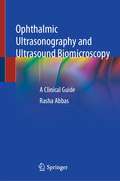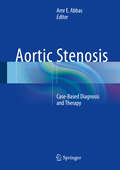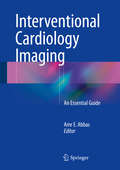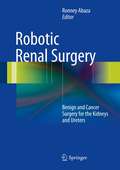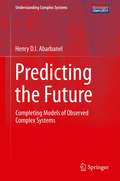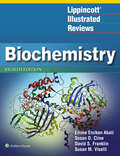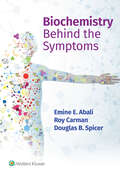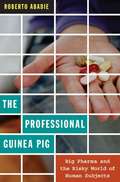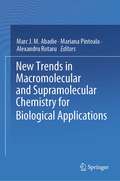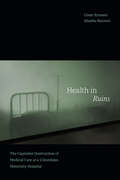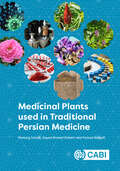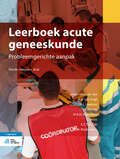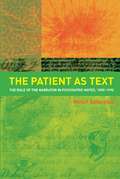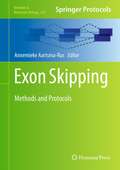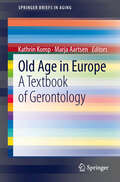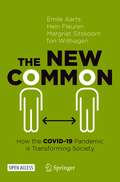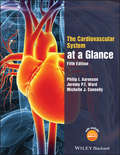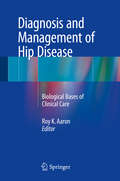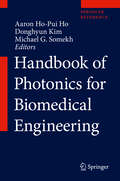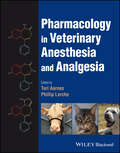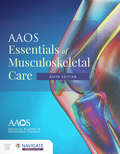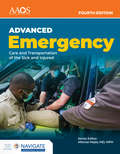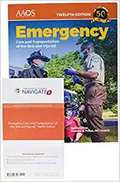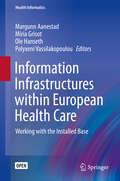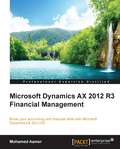- Table View
- List View
Ophthalmic Ultrasonography and Ultrasound Biomicroscopy: A Clinical Guide
by Rasha AbbasThis book provides a visual overview of how to master ultrasonography and ultrasound biomicroscopy techniques. Updated ultrasonic information is included in a simple brief way, featuring didactic points, with a variety of documented scans and illustrated lines underneath for more clarification. Each pathology is accompanied with several scans of different findings to give more information of distinct detections.Ophthalmic Ultrasonography and Ultrasound Biomicroscopy: A Clinical Guide examines many clinical complexities with possible solutions when performing and interpreting ultrasound while also breaking down information for easier intake. The clinical cases are from a specialist eye hospital where many complicated cases are treated, giving a unique insight for the reader to understand treatment for a variety of cases. The book also emphasises the importance of everyday cases with further explanation whilst utilising a diversity of pictures and labels.
Aortic Stenosis: Case-Based Diagnosis and Therapy
by Amr E. AbbasWith the advent of less invasive treatments for aortic stenosis including percutaneous and apical replacement, more patients are being offered this technology. As such, determining the true severity of aortic stenosis is becoming paramount. Many clinical scenarios occur where the area and gradient estimates of severity do not match. This book will present case by case examples of different patients with a wide variety of aortic stenosis. It will assist cardiologists in identifying patients with true aortic stenosis who may benefit from valve replacement. It will also highlight the role and advent of new technology as the role of CTA, MRI, and 3D echo for diagnosis and TAVR and mini surgery for treatment. The audience will range from clinical cardiologists,imaging cardiologists and interventionalists alike.
Interventional Cardiology Imaging
by Amr E. AbbasInterventional cardiology has transitioned from angiographic subjective analysis of stenosis severity into assessment of plaque characteristics and objective assessment of stenosis severity. The evolution of novel interventional imaging modalities is progressively altering our understanding of coronary artery disease diagnosis and prognosis. This book will be an essential companion to assist interventional cardiologists in better assessing patients with Coronary Artery Disease. It will encompass and review all interventional imaging modalities and provide guidance for interventional cardiologists to use these modalities.
Robotic Renal Surgery
by Ronney AbazaRobotic Renal Surgery: Benign and Cancer Surgery for the Kidneys and Ureters provides a comprehensive review of the role of and technical considerations regarding robotic surgery for conditions of the kidney and associated conditions of the upper urinary tract. In addition to serving as a reference regarding indications, preoperative and postoperative management, complications, and evidence-based outcomes, this text also serves as a practical guide for surgeons in how to perform the complete array of robotic kidney and upper tract surgery. Included are detailed descriptions of positioning, instrumentation, and surgical steps for the surgeon newly adopting robotic surgery or for those refining their techniques. All chapters are written by recognized and published experts in the various techniques, creating an authoritative text on the subject. Robotic Renal Surgery: Benign and Cancer Surgery for the Kidneys and Ureters will be of great value to urologists, robotic surgeons, fellows in urologic oncology or endourology as well as urology residents in training and surgical nurses and other surgery team members involved in these procedures.
Predicting the Future
by Henry AbarbanelThrough the development of an exact path integral for use in transferring information from observations to a model of the observed system, the author provides a general framework for the discussion of model building and evaluation across disciplines. Through many illustrative examples drawn from models in neuroscience, geosciences, and nonlinear electrical circuits, the concepts are exemplified in detail. Practical numerical methods for approximate evaluations of the path integral are explored, and their use in designing experiments and determining a model's consistency with observations is explored.
Lippincott Illustrated Reviews: Biochemistry (Lippincott Illustrated Reviews Series)
by Emine E Abali Susan D Cline David S Franklin Susan M ViselliPraised by faculty and students for more than two decades, Lippincott® Illustrated Reviews: Biochemistry is the long-established go-to resource for mastering the essentials of biochemistry. This best-selling text helps students quickly review, assimilate, and integrate large amounts of critical and complex information, with unparalleled illustrations that bring concepts to life. Like other titles in the popular Lippincott® Illustrated Review Series, this text follows an intuitive outline organization and boasts a wealth of study aids that clarify challenging information and strengthen retention and understanding. This updated and revised edition emphasizes clinical application and features new exercises, questions, and accompanying digital resources to ready students for success on exams and beyond.
Biochemistry Behind the Symptoms
by Emine E. Abali Roy Carman Douglas SpicerBiochemistry Behind the Symptoms takes a problem-based approach to understanding and applying biochemistry for superior clinical outcomes. Organized around the common symptoms encountered by clinicians, this engaging text clarifies the connections between foundational science and clinical manifestations to help users form confident diagnoses throughout their clerkship and beyond. Each chapter explores the biochemical concepts behind underlying causes and demonstrates their ties to presenting symptoms through 5 realistic patient cases. Accompanying questions encourage discussion and guide users in building accurate differential diagnoses. Ideal for peer-to-peer learning environments or independent study, this practical approach strengthens users’ application of fundamental knowledge and ensures the long-term retention essential to clinical success.
The Professional Guinea Pig: Big Pharma and the Risky World of Human Subjects
by Roberto AbadieThe Professional Guinea Pig documents the emergence of the professional research subject in Phase I clinical trials testing the safety of drugs in development. Until the mid-1970s Phase I trials were conducted on prisoners. After that practice was outlawed, the pharmaceutical industry needed a replacement population and began to aggressively recruit healthy, paid subjects, some of whom came to depend on the income, earning their living by continuously taking part in these trials. Drawing on ethnographic research among self-identified "professional guinea pigs" in Philadelphia, Roberto Abadie examines their experiences and views on the conduct of the trials and the risks they assume by participating. Some of the research subjects he met had taken part in more than eighty Phase I trials. While the professional guinea pigs tended to believe that most clinical trials pose only a moderate health risk, Abadie contends that the hazards presented by continuous participation, such as exposure to potentially dangerous drug interactions, are discounted or ignored by research subjects in need of money. The risks to professional guinea pigs are also disregarded by the pharmaceutical industry, which has become dependent on the routine participation of experienced research subjects. Arguing that financial incentives compromise the ethical imperative for informed consent to be freely given by clinical-trials subjects, Abadie confirms the need to reform policies regulating the participation of paid subjects in Phase I clinical trials.
New Trends in Macromolecular and Supramolecular Chemistry for Biological Applications
by Marc J. M. Abadie Mariana Pinteala Alexandru RotaruThis contributed volume applies the insights of supramolecular chemistry to biomedical applications such as ions/water transport through nano-scale channels, gene therapy, tissue engineering and drug delivery, to cite some of the major investigations.The challenge is to understand the mechanisms of transport through tissues particularly in the therapeutic treatment of a disease where the active drug must be delivered directly to diseased cells without affecting healthy cells. As a result, smaller quantities of active substances can be used to treat the disease. Another interest concerns new ways to administer gene therapy. If genes are often delivered to their target cells by adapted viruses, the supramolecular non-viral ‘vectors’ using dynamic nano-frameworks and nano-structures are presented. In addition, it is important to reconstruct damaged tissues by mimicking natural processes in cells and polymers, such as tissue engineering and self-healing. Different options are here discussed: e.g. hydrogels based on chitosan, a carbohydrate polymer, are proving especially promising for tissue engineering and drug delivery. For controlled delivery of drugs or other biologically active compounds, hydrogels sensitive to the most important stimuli in the human body, such as temperature, pH, ionic strength, glucose and biomolecules released by the organism in pathological conditions have been developed. Finally, to assist and validate the experimental studies, computer modelling and simulations of large-sized molecular structures and systems using different molecular dynamics and quantum mechanical techniques are developed based on the experimental and chemistry synthesis.This book is of great interest for graduate students, researchers and health professionals interested in acquiring a better understanding of the mechanisms of medical treatments. In addition, it provides numerous tools to develop better therapies for human diseases.
Health in Ruins: The Capitalist Destruction of Medical Care at a Colombian Maternity Hospital (Experimental Futures)
by César Ernesto Abadía-BarreroIn Health in Ruins César Ernesto Abadía-Barrero chronicles the story of El Materno—Colombia’s oldest maternity and neonatal health center and teaching hospital—over several decades as it faced constant threats of government shutdown. Using team-based and collaborative ethnography to analyze the social life of neoliberal health policy, Abadía-Barrero details the everyday dynamics around teaching, learning, and working in health care before, during, and after privatization. He argues that health care privatization is not only about defunding public hospitals; it also ruins rich traditions of medical care by denying or destroying ways of practicing medicine that challenge Western medicine. Despite radical cuts in funding and a corrupt and malfunctioning privatized system, El Materno’s professors, staff, and students continued to find ways to provide innovative, high-quality, and noncommodified health care. By tracking the violences, conflicts, hopes, and uncertainties that characterized the struggles to keep El Materno open, Abadía-Barrero demonstrates that any study of medical care needs to be embedded in larger political histories.
Medicinal Plants used in Traditional Persian Medicine
by Mamak Hashemi Abadi Maryam Akabery Seyyed Ahmad Askari Sayyedeh Fatemeh Askari Zahra Ayati Sajad Azad Parmis Badr Hamed Baharara Zahra Boghrati Mina Borhani Fatemeh Etemadpour Seyed Majid Ghazanfari Shakila Hajizadeh Bahia Namavar Jahromi Lida Jarahi Mohammad Reza Kanani Seyedeh Mahnaz Karimi Abdolali Mohagheghzadeh Leila Mohtashami Ghazaleh Mosleh Nayebzadeh Motahare Maryam Nikoosokhan Roja Rahimi Zahra Taghipour Mojgan Tansaz Meysam Zaeri Elaheh Zibaee Roodabeh Bahramsoltani Amir Hossein AbdolghaffariMedicinal plants and the natural products within them, still remain the starting point for breakthroughs in the development of safe, pharmacologically active synthetic molecules for use in a wide variety of clinical situations. Traditional Persian Medicine (TPM) is one of the most ancient medical doctrines, and is well-documented in terms of information about diseases, diagnoses and treatments, especially in the application of medicinal plants. TPM has been used for centuries worldwide, and many of these methods are still used in Iran today. The book introduces the basics of TPM, and describes the key medicinal plants used for the treatment of different diseases. It also highlights possible new targets for research activities in drug discovery of natural products. The book is richly illustrated with historic drawings from old Persian pharmacopoeia and photos of plants in their natural habitats. Reference to Ayurvedic, Traditional Chinese Medicine and monastic medicine in Europe are also made. While knowledge about medicinal plants used in TPM still exists in Iran there is a risk that the detailed expertise provided by older generations will be lost in the near future. It is therefore very important that this cultural heritage is properly preserved. This book provides a valuable, evidence-based resource on TPM for researchers, practitioners and students in medicinal plants, ethnobotany and herbal medicine.
Leerboek acute geneeskunde: Probleemgerichte aanpak
by A.B. van Vugt M. I. Gaakeer W. Henny H.A.H. Kaasjager C. Motz E.C.T.H. Tan Th. W. WulterkensIn Nederland is het vakgebied van de Spoedeisende Geneeskunde een erkend specialisme. In 2008 is het beroep SpoedEisende Hulp arts (SEH-arts) een begrip geworden. Maar binnen het curriculum geneeskunde verdient de acute geneeskunde meer aandacht. Om die reden is het Leerboek acute geneeskunde geschreven. Het resultaat is een praktisch bruikbaar studieboek, waarin acute geneeskunde op een gestructureerde manier wordt aangeboden aan de student.In Leerboek acute geneeskunde wordt de symptoomgerichte eerste benadering van de acute patiënt naar internationale standaard uiteengezet. Zo wordt de medisch student bekend gemaakt met een aanpak waarin anamnese, diagnostiek en aanvullend onderzoek in hoog tempo worden afgehandeld. Daarnaast is er volop aandacht voor de acute behandeling in geval van (potentiële) levensbedreiging. Aan de orde komen niet alleen de theoretische achtergrondkennis maar ook de praktische vaardigheden die noodzakelijk zijn voor de eerste opvang van de acute patiënt. De opvang en behandeling van de acute patiënt is bij uitstek teamwork, waarbij de inbreng van ieder teamlid van belang is, ongeacht functie, vaardigheid en ervaring. Het belang van crew-resource-management (CRM) is niet te onderschatten.Dit boek is bedoeld voor de medisch student in zowel Bachelor als Masterfase van de studie, maar ook voor verpleegkundig specialisten en physician assistants binnen de acute zorg, zoals in de ambulancezorg, afdelingen SpoedEisende Hulp (SEH) en Intensive Care. Het boek zal ook zijn nut bewijzen voor assistenten in opleiding (AIO) van poortspecialismen, evenals huisartsen, zeker binnen de diensten op een Huisartsen Post (HAP), SEH-artsen en gecertificeerde poortspecialisten.
The Patient as Text: the Role of the Narrator in Psychiatric Notes, 1890-1990
by Petter AaslestadA commonly-held model of the doctor-patient relationship casts it as a subject/object relationship: broadly the patient is a 'text', and the doctor the reader or interpreter of that text. However, recent critical models preset notions of text and reader as complex and unstable, and the relationship of doctor and patient as similarly complicated. Explorations of psychiatry and 'madness' by critics such as Michel Foucault present a further background of complex ideological change. In The Patient as Text, Petter Aaslestad explores selections from over a century of psychiatric notes from Gaustad Hospital, Norway against this critical background, exploring the impact of ideological and medical changes surrounding the psychiatric clinical relationship and psychiatric professionals as constructors of narratives. This book will be of interest to researchers in the medical humanities, psychiatric practitioners, and those with an interest in medical history and critical theory.
Exon Skipping
by Annemieke Aartsma-Rus"Next generation" sequencing techniques allow for more detailed analysis of exons and introns in multiple genes at the same time. This will reveal many mutations that potentially lead to exon skipping. To functionally test these a lot can be achieved with a limited set of protocols, while for the intentional induction of exon skipping different tools and target genes are involved and the translational path from in vitro splicing to in vivo tests in animal models requiring a more extensive set of protocols. Exon Skipping: Methods and Protocols provides scientist with a comprehensive guide to many of the methods and techniques used for exon skipping, such as methods on how to discriminate "real polymorphisms" from mutations that affect splicing. Written in the highly successful Methods in Molecular BiologyTM series format, chapters include introductions to their respective topics, lists of the necessary materials and reagents, step-by-step, readily reproducible laboratory protocols, and key tips on troubleshooting and avoiding known pitfalls. Authoritative and practical Exon Skipping: Methods and Protocols seeks to aid scientists in the continuing study of exon skipping.
Old Age In Europe: A Textbook of Gerontology
by Marja Aartsen Kathrin KompEurope currently is the oldest continent in the world and its population is still ageing. This demographic shift affects society, economy, and welfare states. Scholars from various disciplines and the public noted this development and wonder what effects it may have, but lack adequate information. They call for explanations that are concise and easily accessible. The book at hand fills this lacuna. It introduces readers to the most important developments, theories, concepts, and discussions in ageing studies - always keeping an eye on the current situation in Europe. Each chapter adopts the perspective of a different discipline, e.g. public health, sociology, economics, or technology. To make the explanations easy to understand, the book includes learning tools such as learning objectives, multiple choice questions, and a glossary.
The New Common: How the COVID-19 Pandemic is Transforming Society
by Emile Aarts Hein Fleuren Margriet Sitskoorn Ton WilthagenThis open access book presents the scientific views of some fifty experts on how they believe the COVID-19 pandemic is currently affecting society, and how it will continue to do so in the years to come. Using the concept of a “common” (in the sense of common values, common places, common goods, and common sense), they elaborate on the transition from an Old Common to a New Common. In carefully crafted chapters, the authors address expected shifts in major fields like health, education, finance, business, work, and citizenship, applying concepts from law, psychology, economics, sociology, religious studies, and computer science to do so. Many of the authors anticipate an acceleration of the digital transformation in the forthcoming years, but at the same time, they argue that a successful shift to a new common can only be achieved by re-evaluating life on our planet, strengthening resilience at an individual level, and assuming more responsibility at a societal level.
The Cardiovascular System at a Glance (At a Glance)
by Philip I. Aaronson Jeremy P. Ward Michelle J. ConnollyEverything you need to know about the cardiovascular system... at a Glance! The Cardiovascular System at a Glance is the essential reference guide to understanding all things circulatory. Concise, accessible, and highly illustrated, this latest edition presents an integrated overview of the subject, from the basics through to application. Featuring brand new content on stroke, examination and imaging, heart block and ECGs, and myopathies and channelopathies, The Cardiovascular System at a Glance goes one step further and offers new and updated clinical case studies and multiple-choice questions on a supplementary website. Integrates basic science and clinical topics Offers bite-size chapters that make topics easy to digest Includes coverage of anatomy and histology, blood and haemostasis, cellular physiology, form and function, regulation and integration of cardiovascular function, history, examination and investigations, pathology and therapeutics Filled with highly visual, colour illustrations that enhance the text and help reinforce learning The fifth edition of The Cardiovascular System at a Glance is an ideal resource for medical students, junior doctors, students of other health professions, and specialist cardiology nurses.
Diagnosis and Management of Hip Disease
by Roy K. AaronPresenting recent advances in clinical diagnosis and treatment derived from an increased understanding of the biology of the hip, this unique text examines hip disease and pathophysiology through the lenses of kinematics, biomechanics, anatomy and metabolism. Opening chapters examine the impact of health care organization on hip care and prevalence and burden of osteoarthritis. Biomechanical considerations of the hip and gait pathomechanics in hip disease are then discussed, followed by chapters covering femoroacetabular impingement, possible links between OA and metabolic syndrome, osteonecrosis, osteoporosis and Paget's disease. Considerations of risk reduction surrounding hip arthroplasty conclude the text, including device and surgical options for THA, hip sepsis and prevention of perioperative infection, and management of venous thromboembolism. Taken together, this represents a new and important context for the discussions and management of hip disease for orthopedic surgeons and researchers alike.
Handbook of Photonics for Biomedical Engineering
by Aaron Ho-Pui Ho Donghyun Kim Michael G. SomekhNanophotonics has emerged rapidly into technological mainstream with the advent and maturity of nanotechnology available in photonics and enabled many new exciting applications in the area of biomedical science and engineering that were unimagined even a few years ago with conventional photonic engineering techniques. Handbook of Nanophotonics in Biomedical Engineering is intended to be a reliable resource to a wealth of information on nanophotonics that can inspire readers by detailing emerging and established possibilities of nanophotonics in biomedical science and engineering applications. This comprehensive reference presents not only the basics of nanophotonics but also explores recent experimental and clinical methods used in biomedical and bioengineering research. Each peer-reviewed chapter of this book discusses fundamental aspects and materials/fabrication issues of nanophotonics, as well as applications in interfaces, cell, tissue, animal studies, and clinical engineering. The organization provides quick access to current issues and trends of nanophotonic applications in biomedical engineering. All students and professionals in applied sciences, materials, biomedical engineering, and medical and healthcare industry will find this essential reference book highly useful.
Pharmacology in Veterinary Anesthesia and Analgesia
by Turi Aarnes Phillip LerchePharmacology in Veterinary Anesthesia and Analgesia A concise yet comprehensive and usable pharmacological resource for veterinary practitioners In Pharmacology in Veterinary Anesthesia and Analgesia, a team of distinguished veterinary practitioners delivers a singular and comprehensive text dedicated to anesthetic drug pharmacology and drug interactions related specifically to anesthetic drugs in a veterinary setting. This concise, easily navigable reference combines information scattered throughout the academic literature and covers mechanisms of action of commonly used drugs in commonly encountered species, drug interactions, and clinical uses of anesthetic drugs. The volume explores drug metabolism, the effects of various drugs on organ systems, risks of adverse effects, as well as the impact of anesthesia on drugs, and the effects of drugs on anesthesia. Readers will also find: A thorough introduction to pharmacokinetics, pharmacodynamics, and pharmacogenomics in veterinary anesthesia Comprehensive explorations of veterinary regulatory concerns associated with anesthesia and analgesia for food animals Practical discussions of alpha-2 agonists and antagonists, phenothiazines, butyrophenones, benzodiazepines, and opioid agonists and antagonists Fulsome treatments of local anesthetics, non-steroidal anti-inflammatory drugs, inhalants, and induction drugs Perfect for veterinary anesthesiologists and criticalists, internists, and surgeons, Pharmacology in Veterinary Anesthesia and Analgesia will also earn a place in the libraries of private practitioners and veterinary technicians performing anesthesia as well as researchers using veterinary species as a model.
AAOS Essentials of Musculoskeletal Care
by AAOSEssentials of Musculoskeletal Care, Enhanced Fifth Edition is a robust educational resource focused on how to evaluate and manage common musculoskeletal conditions.
AEMT: Advanced Emergency Care and Transportation of the Sick and Injured Advantage Package
by AAOSThe all-new Fourth Edition of Advanced Emergency Care and Transportation of the Sick and Injured combines comprehensive content with an unparalleled suite of digital resources to fully empower AEMT students and educators.
Emergency Care And Transportation Of The Sick And Injured Essentials Package
by AaosAbout Emergency Care and Transportation of the Sick and Injured, Twelfth Edition: Since 1971, Emergency Care and Transportation of the Sick and Injured has advanced how EMS education is delivered to help train exceptional EMS professionals around the globe. Fifty years later, the Twelfth Edition is now the most advanced EMT teaching and learning system ever developed. Current State-of-the-Art Medical Content Comprehensive coverage of the National EMS Education Standards and the 2020 American Heart Association (AHA) Guidelines for Cardiopulmonary Resuscitation and Emergency Cardiovascular Care (ECC). Evidence-based medical concepts are incorporated to ensure that students and instructors have accurate, insightful interpretation of medical science as it applies to prehospital medicine today. Updated coverage of PPE and CDC guidelines for safe patient care during COVID-19 pandemic. A Focus on Career Readiness and Employability Greater emphasis on soft skill development, including empathy, teamwork, interpersonal skills, and problem solving, and how critical these skills are for better patient outcomes. Enhanced content on provider mental health, wellness, and safety. Evolving patient case studies that deliver clinical education and help prepare students to care for patients in the field. The cases offer increased focus on EMS provider leadership and critical thinking skills throughout the text. A new “Street Smarts” feature that helps bridge the gap between the classroom and field environment by addressing nontechnical skills that improve patient and co-worker interactions. A Foundation for Success The textbook design and layout have been revised to improve visualization of key content and overall readability. Comprehensive anatomy, physiology, pathophysiology, and medical terminology content is delivered in early chapters, and subsequently reinforced in related chapters throughout the textbook. Valuable student resources, including audiobook, interactive lectures, test prep, soft-skill simulations, and videos cater to a variety of learning styles and needs. Educators are supported by a broad range of instructional and assessment resources to fully enable traditional, hybrid, and flipped course delivery.
Information Infrastructures within European Health Care
by Margunn Aanestad Miria Grisot Ole Hanseth Polyxeni VassilakopoulouThis book is open access under a CC BY-NC 2. 5 license. The book aims to be a resource for those interested in planning and implementing large-scale information infrastructures for novel electronic services in health care. The focus of this book is on the pivotal role of the installed base (i. e. the already existing elements of an infrastructure) for ensuing infrastructural development. The book presents rich empirical cases on the design, development and implementation of core infrastructural components (e-prescription and public patient-oriented web platforms) in different national settings across Europe. Therefore, this is a book in which theoretical insights and practical experiences are tightly connected. Contributions have been sourced from a network of academics that have been working on the topic for years, and who have previously collaborated and shared a common understanding of the challenges entailed in expanding information infrastructures within healthcare. The book aims to become a reference for those seeking theoretical and empirical insights for conceptualizing and steering the evolution of information infrastructures in healthcare. The two types of systems (e-prescription and public patient-oriented web platforms) have been selected because they are widespread across Europe, because they invite comparisons, and because they are exemplary of two different types of aims. E-prescription initiatives are usually seen as opportunities to improve healthcare delivery by systematic and not dramatic change. Public patient-oriented web platforms are seen as opportunities to pursue wider and more radical innovation. This book targets researchers, practitioners and students who would benefit from a book providing a comprehensive view to contemporary approaches for the design and deployment of large-scale, inter-organizational systems within healthcare. This book is open access under a CC BY 4. 0 license.
Microsoft Dynamics AX 2012 R3 Financial Management
by Mohamed AamerThis book is intended for application consultants, controllers, CFOs, and other professionals who are engaged in a Microsoft Dynamics AX implementation project. Basic knowledge of financial terms, concepts, and Microsoft Dynamics AX terminologies is required.
